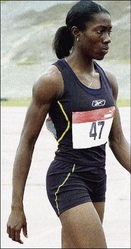An analysis of the chemical found during athletes' tests
Published: Sunday | October 4, 2009





From left, Yohan Blake, Marvin Anderson, Lansford Spence, Allodin Fothergill and Sheri-Ann Brooks.
Peter Ruddock, PhD, Contributor
A substance called 4-methyl-2-hexanamine was found in the urine of five athletes tested at the National Championship in June. The athletes were Sheri-Ann Brooks, Yohan Blake, Marvin Anderson, Allodin Fothergill and Lansford Spence.
The substance was described by the IAAF lab as "an adverse analytical finding" and has resulted in three-month bans being handed down to four of the athletes. Brooks was cleared because proper procedure was not followed for the testing of her B sample.
Vitamin supplement
It was later revealed that the main source of the 4-methyl-2-hexanamine was a vitamin supplement called Muscle Speed.
Most people will probably not be aware that 4-methyl-2-hexanamine is NOT on the WADA list of banned substances. Why were the athletes banned then? It is because the IAAF report stated that 4-methyl-2-hexanamine "has a similar chemical structure or has similar biological effect(s)" to tuaminoheptane. Tuaminoheptane is a compound on the WADA list of prohibited stimulants (section S6 b).
The critical word in the report is "similar" which, as defined by the Oxford dictionary, means "like, alike, resembling something but not the same". Similarity is subjective unless there is agreement on the minimum criteria for similarity. As such, the term has limited use in things scientific. More critical is the extent of similarity. What is the minimum criteria which two compounds must meet before they are deemed similar? Is it 1 per cent, 45 per cent, 90 per cent or 99.9 per cent similarity? Which is it? How similar must 4-methyl-2-hexanamine be to tuaminoheptane? The WADA list does not address this issue of the extent of similarity.
Structural similarity
With respect to structural similarity, if you look at the structures of 4-methyl-2-hexanamine and tuaminoheptane under a special microscope, it would show that both compounds are made up of the same type and the same number of atoms (both are made up of 7 carbons, 17 hydrogens and 1 nitrogen). However, the atoms are connected differently in each compound.
Thus, 4-methyl-2-hexanamine is split into two at both ends of the molecule while tuaminoheptane is longer, straighter, and splits only at one end. Are they similar or not? Without an agreement on the minimum criteria for similarity it is impossible to say.
On the matter of similarity in biological effects, are 4-methyl-2-hexanamine and tuaminoheptane similar? Well, it depends on which biological effects. As athletic stimulants? As nasal decongestants? As anti-cancer compounds? Should it be some similarities? All similarities? Only relevant similarities? What is the minimum criteria to be met here? The WADA list does not address this point.
In my examination of over 100 years of science literature, I have found no studies published which establishes that 4-methyl-2-hexanamine is useful as an athletic stimulant. It would be helpful if WADA or the IAAF shows the scientific basis of deeming 4-methyl-2-hexanamine a stimulant. In fact, scientists at a pharmaceutical company, Eli Lily, said over 60 years ago in a 1944 patent that (sic) "4-methyl-2-hexanamine has a negligible effect on the nervous system" (Shoule and Rohrmann, Eli Lily patent 2,350,318). One similar biological effect between 4-methyl-2-hexanamine and tuaminoheptane, however, is that both have been used as nasal decongestants. Is this similarity enough for the athletes to have been banned, or is this an irrelevant similarity?
4-methyl-2-hexanamine itself is a natural compound which comes from the geranium plant.
The leaves and stalk of the plant can be extracted by steam to give geranium oil. This is a clear to light green oil which has a minty-flowery smell. The oil is used mainly in the food and perfume industries.
Geranium oil
4-methyl-2-hexanamine is one of the minor compounds in geranium oil. It makes up less than 1 per cent of the oil extract. Therefore, in a teaspoon of geranium oil extract, 4-methyl-2-hexanamine would comprise only about one drop.
Each tablet of the supplement Muscle Speed contains less than one-half of 1 per cent of 4-methyl-2-hexanamine. Therefore, it would take more than 2,500 tablets (60 bottles) to provide one teaspoon of 4-methyl-2-hexanamine.
In my estimation, structural similarity should not be used as a criterion by WADA. The only important criteria should be biological effects, that is, how the compounds affect the body. This is because there is no predictable relationship between structure and biological effects. Tests always have to be done. Even compounds which are nearly identical can have vastly different biological effects. There are tens of thousands of examples. Just one will serve to highlight: Thalidomide was a drug prescribed a few decades ago to treat morning sickness in pregnant women. It turned out that thalidomide was not one compound, however, but two nearly identical compounds.
Mirror images
The compounds were, indeed mirror images of each other but, like the human mirror image, the right hand side on one molecule was the left hand side of the other. One of the compounds did alleviate morning sickness but the other caused horrible birth defects. These two thalidomide compounds are nearly identical, yet their biological effects are profoundly different. This sad case emphasises that structural similarity does not mean biological similarity.
So, after considering these points, what are your thoughts on the matter? Is 4-methyl-2-hexanamine similar to tuaminoheptane? Should the athletes have been banned for the presence of 4-methyl-2-hexanamine in their test results? It would be interesting to hear what you think.
Peter Ruddock, PhD, is the branch manager of Tanaud International BV, Chemistry Department, University of the West Indies. Tanaud is a subsidiary of Shire Pharmaceutical (UK) and conducts research into gastrointestinal and central nervous system treatments. Contact him at peter.ruddock@yahoo.com.

















